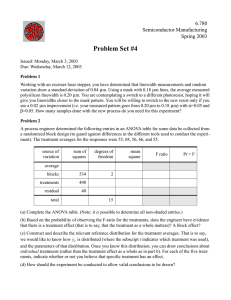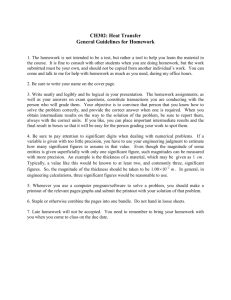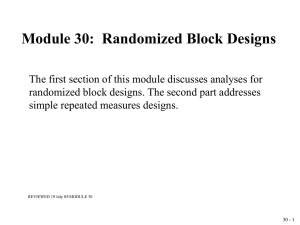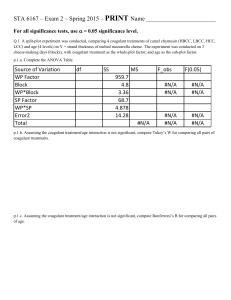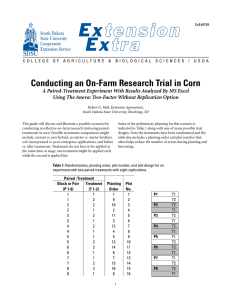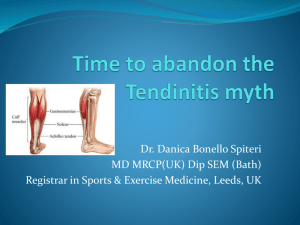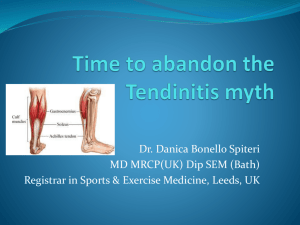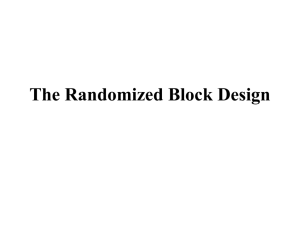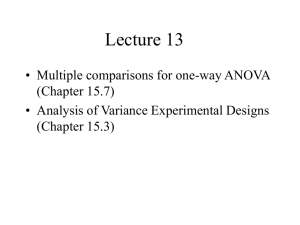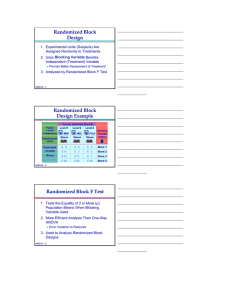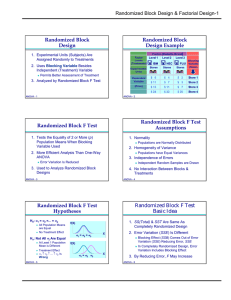chapter102601questio.. - www5555.morris.umn.edu
advertisement
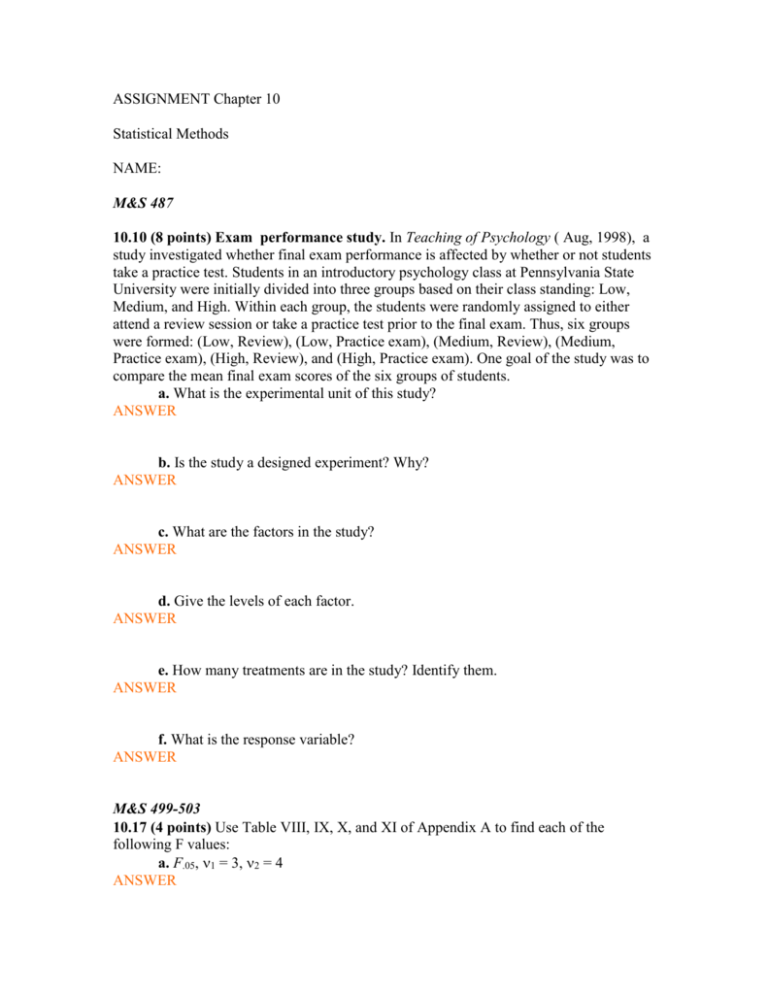
ASSIGNMENT Chapter 10 Statistical Methods NAME: M&S 487 10.10 (8 points) Exam performance study. In Teaching of Psychology ( Aug, 1998), a study investigated whether final exam performance is affected by whether or not students take a practice test. Students in an introductory psychology class at Pennsylvania State University were initially divided into three groups based on their class standing: Low, Medium, and High. Within each group, the students were randomly assigned to either attend a review session or take a practice test prior to the final exam. Thus, six groups were formed: (Low, Review), (Low, Practice exam), (Medium, Review), (Medium, Practice exam), (High, Review), and (High, Practice exam). One goal of the study was to compare the mean final exam scores of the six groups of students. a. What is the experimental unit of this study? ANSWER b. Is the study a designed experiment? Why? ANSWER c. What are the factors in the study? ANSWER d. Give the levels of each factor. ANSWER e. How many treatments are in the study? Identify them. ANSWER f. What is the response variable? ANSWER M&S 499-503 10.17 (4 points) Use Table V, , , and of Appendix A to find each of the following F values: a. F.05, 1 = 3, 2 = 4 ANSWER b. F.01, 1 = 3, 2 = 4 ANSWER c. F.10, 1 = 20, 2 = 40 ANSWER d. F.025, 1 = 12, 2 = 9 ANSWER 10.18 (4 points) Find the following probabilities: a. P (F 3.48) for 1 = 5, 2 = 9 ANSWER b. P (F > 3.09) for 1 = 15, 2 = 20 ANSWER c. P (F > 2.40) for 1 = 15, 2 = 15 ANSWER d. P (F 1.83) for 1 = 8, 2 = 40 ANSWER 10.24 (10 points) The data in the following table resulted from an experiment that utilized a completely randomized design: LM10_24 Treatment 1 Treatment 2 Treatment 3 3.9 5.4 1.3 1.4 2.0 0.7 4.1 4.8 2.2 5.5 3.8 2.3 3.5 a. Use statistical software (or the formulas in Appendix B) to complete the following ANOVA table: Source df SS MS F Treatment Error Total b. Teat the null hypothesis that 1= 2 = 3 , where i represents the true mean for treatment I, against the alternative that at least two of the means differ, Use = .01 ANSWER 10.32 (3 points) Restoring self-control when intoxicated. Does coffee ore some other form of stimulation (e.g., an incentive to stop when seeing a flashing red light on a car) really allow a person suffering from alcohol intoxication to “sober up”? Psychologists from the University of Waterloo investigated the matter in Experimental and Clinical Psychopharmacology (February 2005). A sample of 44 healthy male college students participated in the experiment. Each student was asked to memorize a list of 40 words (20 words on a green list and 20 words on a red list). The students were then randomly assigned to one of four different treatment groups (11 students in each group). Students in three of the groups were each given two alcoholic beverages to drink prior to performing a word completion task. Students in Group A received only the alcoholic drinks. Participants in Group AC had caffeine power dissolved in their drinks. Group AR participants received a monetary award for correct responses on the word completion task. Students in Group P (the placebo group) were told that they would receive alcohol, but instead received two dinks containing a carbonated beverage (with a few drops of alcohol on the surface to provide an alcoholic scent). After consuming their drinks and resting for 25 minutes, the students performed the word completion task. Their scores (simulated on the basis of summary information from the article) are reported in the accompanying table. (Note: A task score represents the difference between the proportion of corrects responses on the green list of words and the proportion of incorrect responses on the red list of words.) a. What type of experiment design is employed in this study? ANSWER b. Analyze the data for the researchers, using = .05. Are there differences among the mean task scores for the four groups? ANSWER c. What assumption must be met in order to ensure the validity of the inference you made in part b? ANSWER 10.42 (4 points) consider a completely randomized design with five treatments: A, B, C, D, and E. The ANOVA F-test revealed significant differences among the means. A multiple-comparison procedure was used to compare all possible pairs of treatment means at = .05. The ranking of the five treatment means is summarized here. Identify which pairs of means are significantly different. a. A C E B D ANSWER b. A C E B D A C E B D E B D ANSWER c. ANSWER d. A C ANSWER 10.47(2 points) Robots trained to behave like ants. Refer to the Nature (Aug, 2000) study of robots trained to behave like ants, presented in Exercise 10.27 (p. 501). Multiple comparisons of mean energy expended for the four colony sizes were conducted with an experimentwise error rate of .05. The results are summarized as follows: Sample mean: Group size: .97 3 .95 6 .93 9 a. How many pairwise comparisons are conducted in this analysis? ANSWER .80 12 b. Interpret the result shown. ANSWER M&S 521-522 10.61(15 points) A randomized block design was used to compare the mean responses for the three treatments. Four blocks of three homogeneous experimental units were selected, and each treatment was randomly assigned to one experimental unit within each block. The data are shown in the following table, and a MINITAB ANOVA printout for this experiment is displayed on p. 522: LM10_61 Block Treatment 1 2 3 4 A 3.4 5.5 7.9 1.3 B 4.4 5.8 9.6 2.8 C 2.2 3.4 6.9 .3 a. Use the printout to fill in the entries in the following ANOVA table: Source df SS MS F Treatments Blocks Error Total b. Do the data provide sufficient evidence to indicate that the treatment means differ? Use = .05 ANSWER c. Do the data provide sufficient evidence to indicate that blocking was effective in reducing the experimental error? Use = .05. ANSWER d. Use the printout to rank the treatment means at = .05. ANSWER e. What assumptions are necessary to ensure the validity of the inferences made in part b, c, and d? ANSWER 10.64 (9 points) Treatment for tendon pain. Refer to the British Journal of Sports Medicine (Feb. 1, 2004) study of chronic Achilles tendon pain, presented in Exercise 10.8 (p. 487). Recall that each in a sample of 25 patients with chronic Achilles tendinosis was treated with heavy-load eccentric calf muscle training. Tendon thickness (in millimeters) was measured both before and following the treatment of each patent. These experimental data are shown in the accompanying table. TENDON Before Thickness After Thickness Patient Patient (millimeters) (millimeters) 1 11.0 11.5 2 4.0 6.4 3 6.3 6.1 4 12.0 10.0 5 18.2 14.7 6 9.2 7.3 7 7.5 6.1 8 7.1 6.4 9 7.2 5.7 10 6.7 6.5 11 14.2 13.2 12 7.3 7.5 13 9.7 7.4 14 9.5 7.2 15 5.6 6.3 16 8.7 6.0 17 6.7 7.3 18 10.2 7.0 19 6.6 5.3 20 11.2 9.0 21 8.6 6.6 22 6.1 6.3 23 10.3 7.2 24 7.0 7.2 25 12.0 8.0 a. What experimental design was employed in this study? ANSWER b. How many treatments are used in this study? How many blocks? ANSWER c. Give the null and alternative hypothesis for determining whether the mean tendon thickness before treatment differs from the mean after treatment. ANSWER d. Compute the test statistic for the test in part c, using the paired difference t formula of Section 9.3. ANSWER e. Use statistical software (or the formulas in Appendix B) to compute the ANOVA F-statistic for the test in part c. ANSWER f. Compare the teat statistics you computed in parts d and e. You should find that F = t2 . ANSWER g. Show that the two tests from part d and e yield identical p-values. ANSWER h. Give the appropriate conclusion, using = .05 ANSWER Total Points: 59
